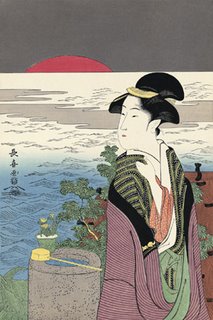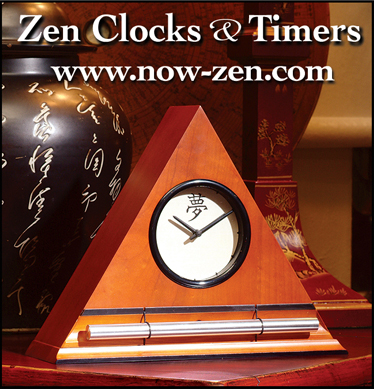
Choki Eishosai, Sunrise at New Year
By approaching the night sky with fresh eyes, you become more intimate with the world.
Starry Night
When we spend time in the wilderness, it can be tempting to focus our awareness on “doing” something: taking pictures; getting a certain amount of physical exercise; traveling from point A to point B; naming all the species of birds we encounter. While nature photography is a lovely craft, and we need to exercise for good health, and understanding what lives in our environment is a valid part of deepening our relationship with the land, these activities can separate us from a more intimate experience of the natural world. It is all too easy to forget to actually experience with all our senses that which we are busily capturing and identifying.
The natural world invites us out of our world of fixed concepts and into a closer proximity with reality—what Buddhist teachings call “nonconceptual awareness.” Experiencing the natural world with nonconceptual awareness means that, rather than seeing a [small] black bird and thinking, “That’s a starling, a nonnative bird introduced from England several centuries ago,” we stop and see each particular bird’s incandescent blue-black velvet feathers, piercing amber eyes, and delicate, wiry feet. Instead of encountering the world through a filter of ideas, memories, and labels, we connect deeply with the unfiltered and vital pulse of life in that moment.
If we’re not mindful, intellectual knowledge can easily cloud our direct experience. When we’re guided through life solely by our intellect, by our ideas of what we know, we’re robbed of a sense of discovery. A nonconceptual awareness allows us to approach each moment as fresh and new. A depth of wisdom can arise from such immediacy, and lead to greater wonder about the mysteriousness of life; we may realize just how little we can ever know.

The beauty and functionality of the Zen Clock/Timer makes it a meditation tool that can actually help you "make time" for meditation in your life. Bring yourself back to balance.
Whatever we experience most often provides us with an excellent opportunity to cultivate nonconceptual awareness. My garden sits in the shade of an old California oak tree that has a wide trunk, deeply veined and wrinkled. The gray-brown bark has deep, dark, vertical grooves intersected by thinner lateral lines——on some days it looks to me like a lopsided checkerboard. Where limbs once grew, there are large knots on the trunk the size of dinner plates. The tree curves gracefully skyward, supporting branches laden with young, shiny, dark green leaves holding their palms to the sun.
When I look at this oak without any preconceived ideas, it is a “different” tree each time I encounter it. My awareness or mood may be slightly different, altering how I see it. Depending on the time of day or time of year, shifting light changes its color. Gentle breezes and strong winds bend the tender limbs into different shapes. From this perspective I forever see it anew. Instead of relating to it solely through a static concept of “oak tree” or failing to see it in all its living, breathing aliveness, I can take it in with fresh eyes. This tree is my constant mindfulness companion, mirroring to me how present and open I am to the freshness of the moment.
The challenge is to be present to all of our experience with such wakefulness. Our concepts of time, of good and bad, of right and wrong can easily distort our ability to see the world clearly. Abiding with nonconceptual awareness allows us to observe the natural world, as well as the people and opportunities we encounter, without the lens of our fixed concepts, views, and opinions. Similarly, we can begin to look at ourselves with a fresh perspective in each moment, without any preconceptions or predetermined limitations.
The following meditation is a way to cultivate a nonconceptual awareness. It works best on a relatively clear night, preferably away from bright city lights. Find a place outdoors where you can lie down on the ground and view the night sky. Gaze up at that vast ocean of darkness that sparkles with infinite stars until you find the cluster of stars known as the Big Dipper. Officially part of Ursa Major, the Great Bear constellation, the Big Dipper consists of seven stars broadly spaced apart. Four stars make the shape of a large rectangle, and the other three splay out horizontally to the left from the top of the rectangle, so they resemble a large dipper, or a saucepan with a long and slightly curved handle.
Once you locate this constellation, try to let go of any preconceived ideas you have about it, and look at the cluster of stars without fixating on the shape of a big dipper. Allow yourself to see seven bright dots amid black space. Notice each star individually. Notice the stars in their context in the sky, within the vast field of shining lights. See how the stars are located in relationship to other stars not in this particular constellation. Observe the spaces between each star. As you continue the meditation, notice if you go in and out of being able to see the stars themselves, without the idea or image of the dipper. If in moments you find it difficult to let go of seeing the Big Dipper, shift your focus to other parts of the night sky. Try looking at just part of the constellation, along with other stars outside the constellation.
Close your eyes for a moment, relax your body, and then open your eyes and refresh your attention using a soft gaze. Let your vision be broad and spacious, and look at the stars without thinking about them, yourself, or anything else—just rest in open awareness. Another approach is to stare at the Big Dipper for a long time; after a while, the concept or memory of a dipper may fade and the stars will return to just being individual lights in the sky.
Once you practice this meditation, you can apply the technique to other constellations—seeing the stars without their associated imagery, taking in the simple reality of what is, and experiencing the vastness of the night sky. Try doing this meditation for up to half an hour, taking time to alternate between simply resting your awareness in the vastness of sky, and noticing whether you get caught up in concepts about specific constellations. You can also expand this practice to include other objects and people—you might try looking at a rose bush without the concept of “rose.”

Our Yoga Timer & Clock can be programmed to chime at the end of the meditation or yoga session or periodically throughout the session as a kind of sonic yantra.
The more you do this, the more you’ll begin to see how using only our preconceived concepts to approach the world can limit our experience and our awareness. Simple concepts can in no way describe the fullness and complexity of any experience or thing, including something as simple as a single, unique maple leaf or mushroom, or something as vast as constellations in the sky.
This technique can also help us approach people with a fresh awareness every time. Try looking at an acquaintance or a loved one without fixing on a preconceived idea about who they are, what they are like, or what they will do. We often get stuck in our concept of who someone is, which limits both people in the relationship.
A dear friend of mine sits his teenage daughter down every year, and they do a playful exercise in which they look at each other, and he says, “I am not your father,” and she says, “I am not your daughter.” This attempt to break down the narrowness of the concepts of “father” and “daughter” allows them to see each other more completely as people, rather than seeing only the parts of each other that relate to the roles they know each other in.
So when you look at someone, notice what concepts arise about them—man, woman, parent, child, waitress, taxi driver, lover. See how your approach to them changes based on your ideas of what it means to be old, young, sick, cute, shy, loud, extroverted, or smart. See then if you can let go of the labels and look at them without these concepts interfering with your perceptions of who they are. Notice their form, movements, and expressions, and try to get a sense of their essence beyond their surface appearance, movements, and expressions. When we look at people or anything in this way, we get to see the world anew, with fresh eyes. We come closer to experiencing the truth of how things actually are, undimmed by the concepts in our minds.

Our Yoga Timer & Clock can be programmed to chime at the end of the meditation or yoga session or periodically throughout the session as a kind of sonic yantra.
Use our unique “Zen Clock” which functions as a Yoga & Meditation Timer. It features a long-resonating acoustic chime that brings your meditation or yoga session to a gradual close, preserving the environment of stillness while also acting as an effective time signal. Our Yoga Timer & Clock can be programmed to chime at the end of the meditation or yoga session or periodically throughout the session as a kind of sonic yantra. The beauty and functionality of the Zen Clock/Timer makes it a meditation tool that can actually help you “make time” for meditation in your life. Bring yourself back to balance.
adapted from yogajournal.com – Excerpted from Awake in the Wild: Mindfulness in Nature as a Path of Self Discovery, by Mark Coleman, with permission from Inner Ocean Publishing. © 2006 by Mark Coleman.

It features a long-resonating acoustic chime that brings your meditation or yoga session to a gradual close, preserving the environment of stillness while also acting as an effective time signal.
Now & Zen – The Meditation Timer Shop
1638 Pearl Street
Boulder, CO 80302
(800) 779-6383
orders@now-zen.com
Posted in Bamboo Chime Clocks, Meditation Timers, Meditation Tools, mindfulness practice